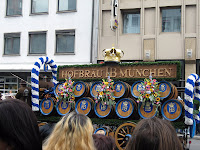 Here it is, my favourite dish ever, pozole. Pozole is one of the most authentic Mexican dishes and it has everything a dish should have, if you ask me. The base is made of corn, same type as corn flour for tortillas is made of, and the rest of the ingredients vary.
Here it is, my favourite dish ever, pozole. Pozole is one of the most authentic Mexican dishes and it has everything a dish should have, if you ask me. The base is made of corn, same type as corn flour for tortillas is made of, and the rest of the ingredients vary. In Mexico corn for pozole is sold either dried or vacuum packed (picture). Outside Mexico it is usually sold canned. Vacuum packed corn does not need to be soaked over night but it still has to be cooked for 2-3 hours until the kernels open.
In Mexico corn for pozole is sold either dried or vacuum packed (picture). Outside Mexico it is usually sold canned. Vacuum packed corn does not need to be soaked over night but it still has to be cooked for 2-3 hours until the kernels open.

After the corn is cooked, meat is added. Pozole can be made with beef, pork, chicken, seafood, or meatless. And depending on which chillies are used pozole can be red, green or white (no chili). My favourite is red pozole made with a mixture of ancho (left) and guajillo (right) chilies.

There are so many different types of pozole that in Mexico there are restaurants who only serve pozole, they are called pozolerias. A must when visiting Mexico.
Pozole
Pozole
serves 4
500 gr pozole corn
400 gr chicken, mixture legs and breasts
1 onion
2 garlic cloves
2 chilies anchos
2 chilies guajillos
salt and pepper
finely chopped radish, avocado, onion, salad (4 tbsp of each)
dried oregano
lime
tostadas (oven dried or fried corn tortillas)
or
totopos (oven dried or fried corn tortilla chips)
Wash corn couple of times, put in a casserole and cook in water until it opens. Do not add any salt as that prevents corn from opening. This takes 2-3 hours. Water needs to be added from time to time. Add the meat, garlic, onion, salt and pepper. When the meat is cooked take it out, let it cool and shred it in small pieces.
Clean the chilies, soak in hot water for about 15 minutes and when soft blend in a food processor. I don't have a food processor or mortar so instead I scrape the flesh, chop it very finely and press through a strainer. Chilies are sometimes very spicy but sometimes not so much, so add them to the corn spoon by spoon.
Serve pozole in bowls, top with fresh vegetables, chicken meat and sprinkle some dried oregano. Totopos and a piece of lime on the side. Lime is squeezed over pozole just before eating.
























